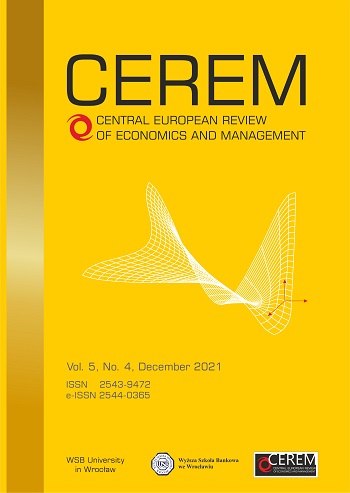Corporate liquidity in normal and crisis times: what is the best yardstick?
DOI:
https://doi.org/10.29015/cerem.927Słowa kluczowe:
cash, working capital, cash conversion cycle, crisis, liquidity measuresAbstrakt
Abstract:
Aim: This paper is meant to investigate measures that help to assess corporate liquidity in both normal and crisis periods.
Design / research methods: We provide an overview of relevant liquidity measures used by both professionals and academics, apply regular liquidity measures on three major European electricity suppliers, study three local cases to find out how a recent crisis affected liquidity and provide an overview of liquidity management on 27 electricity, oil/gas and other multinational firms.
Conclusions / findings: Liquidity measures concentrate on cash ratios, working capital ratios and in specific the cash conversion cycle (CCC). It appears to matter whether a company is production driven or sales driven. In crisis times, whereas priorities do change, liquidity measures should not.
Originality / value of the article: We plead for keeping a close eye on the CCC in both good and bad times. The article provides various recommendations to academics and practitioners.
Bibliografia
Aktas N., Croci E., Petmezas D. (2015), Is Working Capital Management Value-Enhancing? Evidence from Firm Performance and Investments, “Journal of Corporate Finance”, vol. 30(C), pp. 98–13.
Deegan C. (2020), The Necessity of Real-Time Cash Flow Dashboards, The Global Treasurer, August 13, https://www.theglobaltreasurer.com/2020/08/13/ [05.12.2021].
Dorsman A.B., van Montfort C.A.G.M. (2019), The Grid: From a Technical to a Finance Issue. Who Bears the Financial Risk?, Working Paper, Free University Amsterdam, May.
Dorsman A.B., Westerman W. (2019), What Drives Working Capital Levels?, “Hacettepe University Journal of Economics and Administrative Sciences”, vol. 37 no. 1, pp. 41–63.
Faulkender M., Wang R. (2006), Corporate Financial Policy and the Value of Cash, “The Journal of Finance”, vol. 61 no. 4, pp. 1957–1990.
Grube C., Park S.-Y., Rüden J. (2020), Moving from Cash Preservation to Cash Excellence for the Next Normal, McKinsey Corporate Finance Practice, September, https://www.mckinsey.com/business-functions/strategy-and-corporate-finance/our-insights/moving-from-cash-preservation-to-cash-excellence-for-the-next-normal [05.12.2021].
Kakebeeke P., Segenhout J. (2020), AEX bedrijven kunnen eerste klap van de coronacrisis goed zelf opvangen, “Het Financieele Dagblad”, March 25.
Kangas H., Lazarevic D., Kivimaa P. (2018), Technical Skills, Disinterest and Non-functional Regulation: Barriers to Building Energy Efficiency in Finland Viewed by Energy Service Companies, “Energy Policy”, vol. 114(C), pp. 63–76.
Opler T., Pinkowitz L., Stultz R., Williamson R. (1999), The Determinants and Implications of Corporate Cash Holdings, “Journal of Financial Economics”, vol. 52 no. 1, pp. 3–46.
Pätäri S., Sinkkonen K. (2014), Energy Service Companies and Energy Performance Contracting: Is There a Need to Renew the Business Model? Insight from a Delphi Study, “Journal of Cleaner Production”, vol. 66 no. 1, pp. 264–271.
Polàk P., Nelischer C., Guo H., Robertson D.C. (2020), “Intelligent” Finance and Treasury Management: What We Can Expect, “AI & Society”, vol. 35 no. 2, pp. 715–726.
Ross S., Westerfield R.W., Jaffe J. (2019), Corporate Finance, 12th edition, McGraw-Hill Education, New York.
Sagner J.S. (2014), Working Capital Management: Applications and Cases, John Wiley & Sons, Hoboken, NJ.
Seifert B., Gonenc H. (2018), The Effects of Country and Firm-Level Governance on Cash Management, “Journal of International Financial Markets, Institutions & Money”, vol. 52, pp. 1–16.
Snijders B., Gonenc H., Westerman W. (2009), On Dividends and Share Return: Dividend Cuts Help in Crisis Outbreaks, “Journal of Corporate Treasury Management”, vol. 3 no. 1, pp. 8–10.
Talonpoika A., Kärri T., Pirttilä M., Monto S. (2016), Defined Strategies for Financial Working Capital Management, “International Journal of Managerial Finance”, vol. 12 no. 3, pp. 277–294.
Vernimmen P., Quiry P., Dallochio M., Le Fur Y., Salvi A. (2018), Corporate Finance: Theory and Practice, 5th edition, Wiley, Hoboken, NJ.
Vine E. (2005), An International Survey of the Energy Service Company (ESCO) Industry, “Energy Policy”, vol. 33 no. 5, pp. 691–704.
Windaus D., Rosier H., Brady A. (2021), Working Capital Study 20/21: Act Now to Recover, PwC UK.
Westerman W. (2015), Working Capital Management Programs: Yesterday, Today, Tomorrow, “Journal of Modern Accounting and Auditing”, vol. 11 no. 4, pp. 210–217.
Yin R.K. (2018), Case Study Research and Applications: Design and Methods, 6th ed., Sage, Thousand Oaks, CA.
Pobrania
Opublikowane
Numer
Dział
Licencja
Autor przenosi nieodpłatnie na Wyższą Szkołę Bankową we Wrocławiu , bez ograniczeń terytorialnych, majątkowe prawa autorskie do tego utworu w rozumieniu ustawy z dnia 4 lutego 1994 roku o prawie autorskim i prawach pokrewnych ( Dz.U. 1994, Nr 24, poz. 83 ze zm. )na zasadzie wyłączności, tj. prawo do:
a) wyłącznego używania i wykorzystania utworu w dowolnej działalności przez Wyższą Szkołę Bankową we Wrocławiu, w szczególności w działalność Biblioteki Cyfrowej uruchomionej przez Wyższą Szkołę Bankową we Wrocławiu
b) wytwarzania, utrwalania i zwielokrotniania egzemplarzy utworów wszelkimi technikami, w tym techniką drukarską, reprograficzną, zapisu magnetycznego oraz techniką cyfrową, w szczególności ich zwielokrotniania poprzez dokonywanie zapisów na płytach typu CD,
c) zamieszczenia wybranych fragmentów utworu w celach promocyjnych w publikacjach, materiałach promocyjnych, w sieci Internet oraz sieciach wewnętrznych typu Intranet Wyższej Szkoły Bankowej we Wrocławiu,
d) wprowadzania utworu do pamięci komputera Wyższej Szkoły Bankowej we Wrocławiu,
e) kopiowania i powielania utworu w technologiach fotomechanicznych lub innych znanych w dniu zawarcia umowy (fotokopie, kserokopie itp.),
f) przetworzenia dzieła na formę elektroniczną i nieograniczonego rozpowszechniania w sieci Internet.


